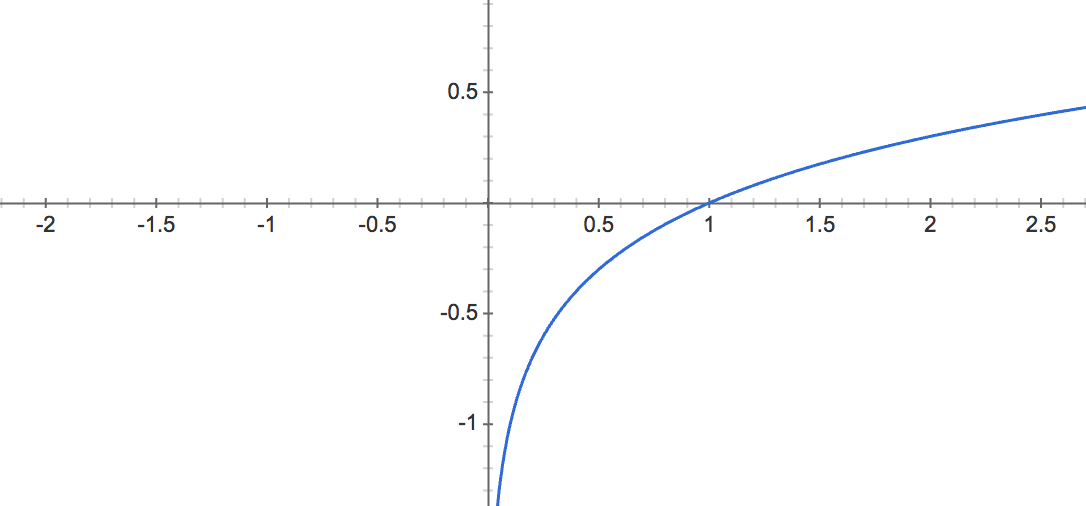Natural logarithm is the logarithm to the base e of a number.
Definition of natural logarithm
When
e y = x
Then base e logarithm of x is
ln(x) = loge(x) = y
The e constant or Euler’s number is:
e ≈ 2.71828183
Ln as inverse function of exponential function
The natural logarithm function ln(x) is the inverse function of the exponential function ex.
For x>0,
f (f -1(x)) = eln(x) = x
Or
f -1(f (x)) = ln(ex) = x
Natural logarithm rules and properties
| Rule name | Rule | Example |
| Product rule | ln(x ∙ y) = ln(x) + ln(y) | ln(4 ∙ 5) = ln(4) + ln(5) |
| Quotient rule | ln(x / y) = ln(x) - ln(y) | ln(4 / 5) = ln(4) - ln(5) |
| Power rule | ln(x y) = y ∙ ln(x) | ln(37) = 7 ∙ ln(3) |
| ln derivative | f (x) = ln(x) ⇒ f ' (x) = 1 / x | |
| ln integral | ∫ ln(x)dx = x ∙ (ln(x) - 1) + C | |
| ln of negative number | ln(x) is undefined when x ≤ 0 | |
| ln of zero | ln(0) is undefined | |
 | ||
| ln of one | ln(1) = 0 | |
| ln of infinity | lim ln(x) = ∞ ,when x→∞ | |
| Euler's identity | ln(-1) = iπ |
Logarithm product rule
The logarithm of the multiplication of x and y is the sum of logarithm of x and logarithm of y.
logb(x ∙ y) = logb(x) + logb(y)
For example:
log8(4 ∙ 5) = log8(4) + log8(5)
Logarithm quotient rule
The logarithm of the division of x and y is the difference of logarithm of x and logarithm of y.
logb(x / y) = logb(x) – logb(y)
For example:
log8(4 / 5) = log8(4) – log8(5)
Logarithm power rule
The logarithm of x raised to the power of y is y times the logarithm of x.
logb(x y) = y ∙ logb(x)
For example:
log8(39) = 9 ∙ log8(3)
Derivative of natural logarithm
The derivative of the natural logarithm function is the reciprocal function.
When
f (x) = ln(x)
The derivative of f(x) is:
f ‘ (x) = 1 / x
Integral of natural logarithm
The integral of the natural logarithm function is given by:
When
f (x) = ln(x)
The integral of f(x) is:
∫ f (x)dx = ∫ ln(x)dx = x ∙ (ln(x) – 1) + C
Ln of 0
The natural logarithm of zero is undefined:
ln(0) is undefined
The limit near 0 of the natural logarithm of x, when x approaches zero, is minus infinity:
![]()
Ln of 1
The natural logarithm of one is zero:
ln(1) = 0
Ln of infinity
The limit of natural logarithm of infinity, when x approaches infinity is equal to infinity:
lim ln(x) = ∞, when x→∞
Complex logarithm
For complex number z:
z = reiθ = x + iy
The complex logarithm will be (n = …-2,-1,0,1,2,…):
log z = ln(r) + i(θ+2nπ) = ln(√(x2+y2)) + i·arctan(y/x))
Graph of ln(x)
ln(x) is not defined for real non positive values of x:

Natural logarithms table
| x | ln x |
| 0 | undefined |
| 0+ | - ∞ |
| 0.0001 | -9.210340 |
| 0.001 | -6.907755 |
| 0.01 | -4.605170 |
| 0.1 | -2.302585 |
| 1 | 0 |
| 2 | 0.693147 |
| e | ≈ 2.7183 |
| 3 | 1.098612 |
| 4 | 1.386294 |
| 5 | 1.609438 |
| 6 | 1.791759 |
| 7 | 1.945910 |
| 8 | 2.079442 |
| 9 | 2.197225 |
| 10 | 2.302585 |
| 20 | 2.995732 |
| 30 | 3.401197 |
| 40 | 3.688879 |
| 50 | 3.912023 |
| 60 | 4.094345 |
| 70 | 4.248495 |
| 80 | 4.382027 |
| 90 | 4.499810 |
| 100 | 4.605170 |
| 200 | 5.298317 |
| 300 | 5.703782 |
| 400 | 5.991465 |
| 500 | 6.214608 |
| 600 | 6.396930 |
| 700 | 6.551080 |
| 800 | 6.684612 |
| 900 | 6.802395 |
| 1000 | 6.907755 |
| 10000 | 9.210340 |
